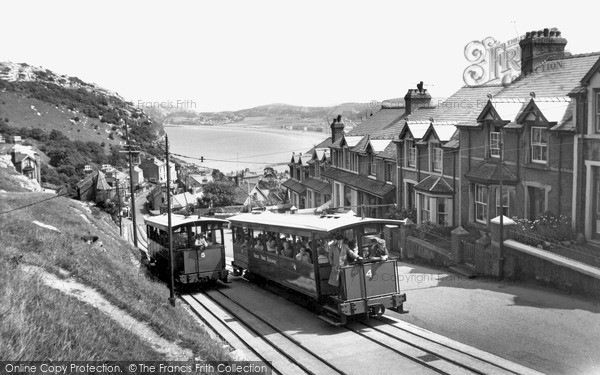Great Orme Railway, Ty Gwyn Road Passing Loop
A Memory of Llandudno.
The Great Orme Tramway is split into an upper and lower section at Halfway station. This photo is taken on the lower section at the middle passing place, situated on Ty Gwyn Road just above Black Gate. At this point, car 4 takes the outer rails to pass car 5 which passes on the hillward side. The roadway here is 'pinched' [ie it suddenly narrows] and has on occasion been the scene of minor crashes with cars heading downhill whose drivers have not taken into account the outward swing of the front of the tram. Despite safety road markings, the tram driver sounding his warning horn etc., the writer was conducting number 4 on the occasion of a brand new car heading downhill venturing into the danger zone and having it's front and nearside panels brutally filleted by the front left step. The car driver waved his hands as if to indicate to the tram driver [who rejoiced in the nickname of "Bob Dog" ] to steer away!!! As if he could!!! The car was very severely damaged but the tram sustained only a minor scratch to its paintwork on the step. Our passengers were unharmed and seemed to think that the 'Brummie' car driver's antics and [understandable] hysteria were very entertaining. When the police attended, they even suggested that his bad driving was entirely to blame - cue for more hysteria and unsympathetic laughter from the passengers!!! After twenty minutes delay we were off again towards Halfway station. Up past Ty Gwyn curve and on to Killens Hill, the steepest part of the lower section. The steepest gradient is approximately 1 in 39; this is where the yearly safety tests are carried out before the season begins. The tram is overloaded with sandbags, the speed governor is bypassed to allow for a speed in slight excess of 5mph and when the brake is applied the tramcar stops in approx 10 feet. Fantastic to observe. The trams in the photo are in the dark blue livery which was changed to a brighter shade in the 1980s. [The original livery was 'Deep Ochre' but was replaced within a few years of the line opening by a very dark blue which, with the appliccation of several coats of varnish appeared almost black.]
As opened, the tramway had two types of tramcar. Cars numbered 1, 2 and 3 were small, four wheeled trailers which were used to carry goods and coal fuel for the winding house boilers. Occasionally used to convey coffins to Halfway from whence funeral corteges would carry them to the nearby St. Tudno's Church for burial; these small tramcars ceased to be used in the early 1920s and lay, unused and unloved, at Halfway, becoming an increasing eyesore. By 1930 they had all been disposed of as store-huts at the local farms. [The last one was at Pink Farm until the 1950s, but by that time it's passengers were chickens and the occasional goat.]
The remaning four passenger cars are numbers 4 & 5 which work on the lower section, with numbers 6 & 7 on the upper. They are 37 feet in length with transverse wooden seating for 48 passengers. They were constructed in 1902/3 before people considered their awkward access for disabled or youthful passengers, let alone modern day [supposedly] collapsable prams! There are no side windows in any of the trams, the only slight concession to comfort being glazing to the end bulkheads. This prevents winds blowing from one end of the car to the other, but is no protection from winds and rain blowing accross the cars. The nature of construction of the cars has to allow for considerable deflection to their structures, they 'twist'. Any attempt to fully glaze them would fail.
The driving staff were for many years provided with 'ironmongers' brown dustcoats as a basic uniform. For some years in the 1950s these became dark grey. In the early 1990s the tramway's administrator and [effectively] manager Rosemary Sutton, designed new uniforms in mid blue with gold braiding. After looking rather downmarket for many years, the staff now looked like airline pilots. This heralded a continuing period of municipal pride in the tramway.
The overhead wire to which the tram was connected by means of a trolley pole, was used to signal to the winding house which was situated at Halfway station. Small telephones were fitted above each tramcar's platforms, these being used to communicate to the winding house when the trams were ready to proceed or needed to stop. This cumbersome process lasted until 1990 when radios took over.
Similarly, for many years the only warning of the approach of a tram would be the clanging of a gong, operated by a treadle on the floor of each car's platform. These were barely audible above the general clangour of the car so they were replaced at the same time as the telephones, with hand held, compressed air warning horns.
The Great Orme Tramway is, in 2008, equipped with effective and modern safety and operating equipment. Recent track relaying and the creation of a modern Halfway depot which incorporates modern engineering, operating and passenger facilities, make a ride a great experience. One of only a few surviving street cable tramways [others at San Francisco and Lisbon], it's survival is an amazing example of Victorian engineering and a credit to it's owners and the men who keep it going.
Add your comment
You must be signed-in to your Frith account to post a comment.
Add to Album
You must be signed in to save to an album
Sign inSparked a Memory for you?
If this has sparked a memory, why not share it here?




Comments & Feedback
Be the first to comment on this Memory! Starting a conversation is a great way to share, and get involved! Why not give some feedback on this Memory, add your own recollections, or ask questions below.